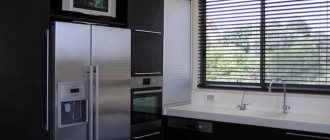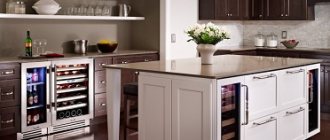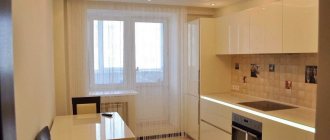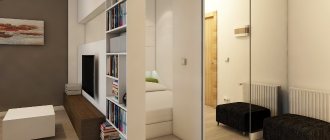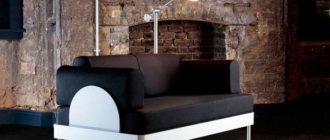Although a microwave in the kitchen does not take up very much space, unlike, for example, a refrigerator, finding a suitable place for it can be difficult. Perhaps there are no problems only with built-in equipment; it is initially purchased for a specific niche. Other types of microwaves are placed in the kitchen in different ways: on tables, in corners, on shelves, etc., except that they are not hung above a gas stove. This material discusses various options for placing microwave ovens, as well as the rules that it is advisable to adhere to when determining the place where the purchased equipment will be located.
Ideas for placing a microwave oven
The question of where to put a microwave in the kitchen so that it is convenient to use arises even if you have a spacious kitchen, not to mention small rooms. The point here is often not only in the available square meters. For example, the location of kitchen outlets already limits the way the microwave can be placed. The optimal location of the stove can compete with the TV - in general, there are not many places where this device can be placed. Nevertheless, there are enough ideas for placing such equipment, so you can almost always find an acceptable option. Let's look at these options in detail.
Spices that have been stored for a long time can be restored to their former aroma using a microwave oven. To do this, just warm them up in a closed bag for about fifteen seconds.
Placing freestanding microwaves
If a built-in model is available, then the question of how to place a microwave in the kitchen does not arise. In this case, there is a niche in the kitchen unit for the microwave, and the device is purchased specifically for this niche. However, the vast majority of home microwave ovens are free-standing units and there are many options for placement. The optimal location depends on specific conditions: the size of the kitchen, the dimensions of the oven itself, the location of kitchen outlets, etc. Below are options for freestanding microwave ovens that can be applied to almost any kitchen.
Kitchen countertop
The simplest and most common way to place a microwave oven in the kitchen is to install it on the kitchen countertop. This option has a number of advantages, namely:
- a stove placed in this way is at the optimal height for a person - there is no need to reach up or bend down to use this device;
- the countertop itself is a kitchen work area, so the stove installed there will be located not far from other kitchen equipment, various utensils, hoods, products, etc. — everything necessary, including the stove itself, will be at the user’s fingertips;
- In addition, the countertop is a flat, stable surface - this is exactly what is most suitable for a microwave.
Unfortunately, it is not always possible to install a microwave oven on the countertop. In small-sized kitchens, the size of the countertop itself is limited, and installing a microwave there significantly, and sometimes radically, reduces the available work surface. In addition, it is not advisable to place the stove next to a gas or electric stove, or next to a sink. So, when deciding where to put a microwave in a small kitchen, you often have to consider other options.
Windowsill
One of the options for solving the question of where to put a microwave in a small kitchen is to install it on a windowsill, if, of course, the size of this window sill allows. Wide window sills are similar to a kitchen countertop, but they are “recessed” into the wall, forming a kind of niche, similar to those in which kitchen equipment is built. The height at which the window sills are located usually approximately corresponds to the height of the kitchen worktop, i.e. is optimal for the user. The surface of the window sill itself is flat, and there are no problems with stability.
Despite all the listed advantages, the option of installing a microwave on a windowsill is not without significant drawbacks. Let's list them:
- The stove may be exposed to direct sunlight, and this is undesirable, because they can heat up the equipment greatly, which will eventually lead to damage to the device;
- a window can be a source of drafts, condensation and sudden temperature changes, which also negatively affects the performance and durability of the equipment;
- the microwave restricts access to the window; it cannot be opened without removing this device;
- If there are heating batteries under the windowsill, the equipment located on the windowsill will overheat during the heating season.
Fridge
If there is not enough space, you can, in principle, put a microwave on top of the refrigerator in a small kitchen, if, of course, the refrigerator has an acceptable height. This is far from the best option, but if there is an acute lack of space, it is also used. Among other things, the vibration of the refrigerator during operation is also a disadvantage; over time, this negatively affects the equipment located on it.
When using a refrigerator to place a microwave oven, it is recommended to install the oven not directly on the top of the refrigerator, but to use some kind of stand made of heat-insulating material. It is also a good idea for the stove to stand on small legs - this will improve its ventilation and reduce the flow of excess heat to the refrigerator.
If a microwave oven that failed before the expiration of the warranty was placed on a refrigerator during the period of operation, this may become grounds for refusal of warranty service.
Dishwasher
Often a situation arises when the purchased stove is difficult to attach anywhere, because... all convenient places are already filled with various kitchen equipment. Is it possible to install it on another device in this case? I guess, yes. One option is to install a microwave on the dishwasher. The surface of such a machine is smooth and stable. The machine itself does not overheat during operation. Nevertheless, it is advisable, as in the case of a refrigerator, to install the microwave oven not directly on top, but on a thermally insulated stand. Also, it is not recommended to turn on both of these devices at the same time.
Washing machine
If there is too little space in the kitchen unit to accommodate a microwave, you can also install it on the washing machine. This is far from the best option. On the one hand, a standard washing machine is suitable in height, and its surface area is quite enough to install a stove. On the other hand, you need to remember that the washing machine vibrates during operation, so it is advisable to provide some kind of microwave mat that prevents this device from slipping. You should not install an oven that is too heavy on the washing machine; it can simply deform the surface of the washing machine. It is recommended not to place models that weigh more than fifteen kilograms on washing machines.
Hanging open shelf
If there is not enough space for placing a microwave oven, you can adapt any open shelf. It is only necessary that it be securely attached to the wall, support the weight of the stove, and be installed at a height comfortable enough to use the microwave. Usually the shelf is located closer to the outlets and the kitchen work area, but in principle it can be placed anywhere - in a corner, in the middle of the wall, etc., except that they avoid placing a microwave above the stove.
You can build a shelf yourself, order its production, or use a purchased product. Shelves are usually made from suitable materials that are easy to clean from accumulated dirt. In addition, industrial kitchen shelves often have additional capabilities; for example, various kitchen utensils can be hung from below the shelf.
Shelf under wall cabinets
Actually, this is the same open shelf for a microwave oven, only installed under wall kitchen cabinets. The advantage of this location is that the microwave will be located directly in the kitchen work area, without taking up space on the countertop. So this is a good option, even if there is somewhere to put the microwave.
Niche in the kitchen cabinet
Kitchen sets often have niches that can be used to install household appliances, including microwave ovens. Typically, such niches are of an open type and do not have doors, which, in general, almost completely solves the problem of ventilation of household appliances during operation. Niches, as a rule, are located either directly in the kitchen work area or not far from it. Perhaps the main problem when using niches is connecting equipment to the electrical network.
bracket
Among the various ideas for placing microwave ovens, the most popular option is using a bracket. This option, in fact, is very close to using a regular shelf, but the bracket looks more stylish. The bracket does not have any advantages over the shelf. When deciding where to install it, very often they choose the kitchen work area, namely the section of the wall under the wall cabinets.
Dinner table
Placing the microwave on the kitchen dining table is not a very good option. Household appliances will take up space, and people eating food will have to crowd together. In addition, dining tables are usually located away from the kitchen work area. Otherwise, there are no problems - the surface of the table is flat and stable, its height allows you to comfortably use the equipment, there are no problems with the ventilation of this equipment, because she stands open. In addition, external heat sources that negatively affect the performance of equipment are usually located away from the table.
Microwaves placed below the countertop may become an object of interest for young children, which is unsafe for them and for the equipment itself. So if there are young children in the family, it is advisable to purchase a model that has child protection.
Bar counter
If the size of the kitchen allows, then you can also equip a bar counter there, on which, in turn, you can install a microwave oven. In essence, this solution is similar to the option of placing similar equipment on the kitchen table, which was described above. This option does not have any special advantages, nor, indeed, any disadvantages. Using a microwave oven located on the bar counter will be quite convenient - the height of the counter is comfortable, the equipment is located openly, and there are no problems with its ventilation.
Rack
If the kitchen is spacious enough, the kitchen set, among other things, can be equipped with a special rack designed for kitchen appliances. You can also install a microwave oven on the shelf of such a rack. The rack is interesting because when used, most of the equipment samples are not distributed throughout the kitchen, but are concentrated in one place. Those devices that are regularly used (microwave ovens among them) are placed so that they are convenient to use. The rest is placed at the very top or bottom of the rack and removed from there as needed.
Placement of built-in microwave ovens
Built-in models usually have a stylish appearance and are an important component of the overall kitchen interior design. In addition, they often belong to premium class equipment. The options for placing microwaves of this type in the kitchen are limited, since they are installed in a special niche in the kitchen furniture. If such a niche is missing, but a built-in model is available, you will have to additionally purchase appropriate furniture. Let's figure out how to build such a device so that it is as convenient to use as possible.
Under the table top
This is one of the frequently used options for placing a microwave oven. On the one hand, being under the countertop, it is, as they say, always at hand. On the other hand, the low location is not very convenient; you have to bend down when placing food, controlling the cooking process or removing the prepared dish. Caring for this equipment if necessary is also not entirely comfortable.
However, the inconvenience of such a location is not so great as to refuse it. The ability to hide equipment so that it is easy to reach if necessary is very attractive in the eyes of users. Built-in ovens are also placed under the countertop, and this does not create any tangible problems for users.
Corner cupboard
One of the elements of kitchen sets designed for spacious kitchens are corner cabinets, located, as you might guess, in the corners of kitchens. Among other things, this is a convenient place to place a built-in microwave. This technique, in principle, can be installed at any level of the cabinet, as long as there is only a suitable niche. Most often it is installed at tabletop level or slightly higher. This location is quite convenient for both using equipment and servicing it. In addition, corner cabinets are usually located within the kitchen work area, which is very convenient for the user.
Set
To install built-in microwave ovens, the best option is to use a kitchen unit with a pre-designed placement of this equipment. Ideally, everything needs to be pre-planned and the issues resolved in a comprehensive manner at the stage of thinking through the details of the kitchen interior: choose the most convenient place in the set for installing a microwave oven, select the oven itself in such a way that it fits completely into the design of the set and the design of other kitchen equipment.
The usual approach in such cases is to order a headset for specific requirements, as well as use equipment from the same manufacturer, moreover, made in the same style. Of course, this approach is very difficult to implement in a small kitchen and insufficient financial resources, but standard sets also provide niches for embedding various equipment.
Using a microwave oven, you can significantly restore the quality of stale bread. To do this, you need to wrap the sliced slices of bread in damp cloth napkins and heat them in the oven for about ten seconds at maximum power.
Above the hob
Let's figure out whether it is possible to hang a microwave above the hob. If there is not enough space, the microwave oven can be hung on a bracket or installed on a shelf directly above the stove. This is a very controversial solution, extremely rarely implemented in practice. This is done in cases where there is absolutely nowhere to put the equipment. If the microwave is installed above the hob, this will entail a number of negative aspects for the equipment, namely:
- the microwave above the stove will be regularly exposed to high temperatures, steam, splashes of oil and grease;
- there will be no place to install the hood;
- when the hob is used for cooking, it is difficult to use the microwave at the same time;
- The equipment itself will have to be installed high enough to reduce the negative impact of cooking, so it will be awkward to reach.
Niche in the wall
If there is a niche in the wall in a suitable place and at a suitable height in the kitchen, then various household appliances, including a microwave oven, can be placed there too. The advantage of this solution is that the equipment will be “recessed” into the wall and will not take up extra space. Connecting equipment to the electrical network may be a problem. In extreme cases, you can use an extension cord. Optimal is the presence of an outlet in the niche itself.
Above the oven
Placing a microwave above the oven is a controversial decision. Its advantage is that the cooking equipment is assembled into a single unit and placed in a place convenient for the user. From a design point of view, such a solution is also advantageous, especially if equipment from the same manufacturer is used, made in the same style.
However, this solution also has a significant disadvantage. So, from a working oven, various cooking fumes rise upward, which first reach the microwave oven. Over time, this affects both its appearance and performance. Therefore, the described solution is used infrequently; usually the oven is combined with a hob and a hood is installed above them.
Kitchen island
One idea for placing various equipment in the kitchen is to use a so-called kitchen island. The concept of the island is that the main kitchen furniture is installed in the center of the kitchen, rather than placed along the walls. A built-in microwave oven can also be installed in such furniture. It is usually placed under the countertop. The advantages and disadvantages of such placement are described in detail above.
Pencil case
A pencil case is an element of a kitchen unit, which is a tall and relatively narrow rack. It may be equipped with doors or be partially or completely open. To install a built-in microwave oven, you will need a special niche. This method of placement does not have any special advantages or disadvantages. For user comfort, it is recommended to install built-in appliances at tabletop level or slightly higher. It is advisable to place the pencil case itself directly in the work area or next to it.
Pull-out microwave ovens
There is a special type of built-in microwave ovens, which differ from conventional ones in that the front panel does not tilt or swing open, but extends along with the tray for loading products. Products in such equipment are loaded from above, into an extended tray. Installing a microwave of this type is no different from installing conventional built-in models. A standard niche in kitchen furniture is suitable for it.
Separate room
In some cases, if there is sufficient space, they organize a separate room where they collect most of the kitchen equipment, and sometimes other household appliances - microwave ovens, washing machines and dishwashers, convection ovens and vacuum sealers, etc. This decision is quite controversial. On the one hand, the kitchen is freed from excess equipment, on the other hand, this equipment is too far away from the main kitchen work area.
There is a good way to disinfect a sponge that was used to remove meat stains, greasy stains, etc. It is necessary to moisten a sponge in water, sprinkle vinegar or lemon juice on it and keep it in the microwave for about a minute, operating at full power.
Above the kitchen stove
Not always the most beautiful option, unlike the case with a built-in hood, but effective for making the most of a limited space.
Pros: The microwave and range hood do double duty to save space in a compact kitchen.
Con: If the microwave is placed too high, it will be difficult for many users to reach. It also makes the hood fan somewhat less elegant looking and prevents effective ventilation.
Design Considerations: Your microwave will benefit from matching the style of your kitchen oven, so try to ensure that both appliances are from the same manufacturer.
Once this is done, installation is very simple and usually takes a few hours, depending on how long it takes to remove the existing hob, hood and microwave, and whether the countertops and kitchen units need to be cut to fit the new units.
Where to make a socket for a microwave
It is recommended to plan the location of all kitchen outlets, including those for the microwave oven, only after the kitchen design has been approved and it becomes clear where the kitchen equipment will be located. After this, it is very easy to determine the installation locations of the sockets - they are placed next to the equipment. If it is not possible to adhere to this principle, then it may turn out that the kitchen will be literally entangled in extension cords. This will not have the best effect on both its appearance and the reliability of the power supply to household appliances.
In the corner closet
A convenient option for large kitchens, where deep corners remain unused in any case.
Pros: fills a corner and faces the room, making it easier to use. Allows better use of a deep cabinet that may contain other hard-to-reach items.
Con: Some areas behind the stove will be unused, as well as behind other appliances or drawers.
Recommendations from manufacturers for installing microwave ovens
When choosing a location for placing a microwave in the kitchen, it is advisable to follow the recommendations from manufacturers, as well as kitchen interior specialists. These recommendations are as follows:
- if the place where you can place the microwave is located next to equipment that generates heat during operation, then you do not need to install the stove close to such equipment, you must place it at a distance of at least 10 cm from it;
- it is advisable to install the microwave oven at a distance of no less than 15 cm from the wall;
- the optimal height for placed equipment is considered to be from half a meter to one and a half meters above floor level;
- The surface on which this equipment is placed must be level and stable.
Built into the kitchen unit
A brilliant option for those users who like their equipment to look beautiful.
Pros: The height can be adjusted for better accessibility.
Cons: If the microwave is too far from the countertop, then if you need to remove a hot plate from it, there is a danger of not knowing where to immediately put it.
Tips: It's very difficult to remodel unless the cabinet is of significant height and dimensions, and you may need a custom cabinet with the height you need (or you'll have to settle with one of your designer's standard options).
Where should you not place a microwave?
There are places in the kitchen where it is undesirable to install microwave ovens, as this can lead to their rapid failure. We list the restrictions on the placement of these devices:
- These devices should not be placed close to radiators or heating elements;
- you need to install them away from gas burners and sinks;
- It is undesirable for the microwave oven to be exposed to direct sunlight - equipment installed on window sills is especially susceptible to this danger;
- Steam and hot splashes of fat do not have the best effect on this equipment, so the idea of hanging a microwave over a stove or multicooker is no good;
- It is not advisable to place such equipment near the TV, as this may cause problems with the TV.
In the "garage" for equipment
A great, fashionable option for those who want to hide multiple appliances between uses.
Pro: hides small appliances at the height of the work surface, as a result of which they are always at hand.
Cons: it forces you to allocate additional space for this, which is somewhat more troublesome than just keeping them on the countertop. What you need to know: A narrow countertop can be converted into an appliance “garage,” although the best option would be a very deep countertop (30 inches rather than 24 inches) to leave usable space in front.
If you're adding a door, use a contrast (like metal) if you can't match the existing paint, otherwise the style will be disrupted.
Safety and convenience of accommodation
In order to combine the safety of the equipment and the convenience of its placement, you should adhere to certain criteria when choosing the location of the microwave oven. Let's list them:
- equipment that is excessively heated from external heat sources when turned on and continues to operate can quickly fail (external heating up to 40˚C is considered unsafe), so it is advisable to keep it away from heat sources and direct sunlight;
- this equipment is negatively affected by vibration, so it is advisable not to place it on other equipment that vibrates during operation;
- steam and high humidity also negatively affect the performance of equipment;
- it is necessary to ensure normal ventilation of operating equipment, for which it must be placed at a certain distance from the wall and other equipment (at least 10-15 cm);
- when choosing a suitable location, you need to take into account how the door of the microwave oven swings open, otherwise nearby equipment or furniture may interfere with the normal opening of the door;
- It is optimal to have sockets near the equipment; the use of extension cords reduces the reliability of the power supply to the equipment.
Why is location so important?
It is necessary to decide how to install a microwave in accordance with safety rules, ease of use of this equipment and, if possible, taking into account the overall style of the kitchen. In other words, the location for the microwave should be safe for equipment and people, convenient for the user and fit into the design of the room. Installing this equipment in an inappropriate location usually leads to fairly rapid failure. In addition, the equipment itself in this case may become a source of danger for the user.
The highest heating of the microwave oven occurs when using the grill function. Therefore, if such equipment is installed in an insufficiently ventilated place or close to heat sources, it is better not to use this function.
